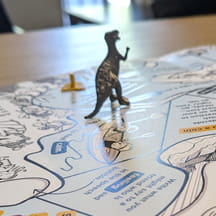The grand opening of the Borowy Family Children’s Critical Care Tower at Wolfson Children’s Hospital this month means the addition of a much-needed increase in hospital capacity for the children of the rapidly growing Jacksonville, Florida, area. But for the hospital’s leadership, the building also represents a bridge to the next generation of pediatric health care.
“We sought state-of-the-art technology that transforms the way our physician specialists and other clinicians care for our patients,” says Michael Aubin, FACHE, hospital president, Wolfson Children’s Hospital. “This is something we couldn’t have even dreamt of when we opened our first NICU and PICU half a century ago—but now, the future is here.”
A.I. functionality to enable faster interventions, improved outcomes
The new building includes five floors dedicated to children’s intensive care, including a three-floor NICU, a neuro-intensive unit, a cardiovascular intensive care unit and a unit dedicated to treating children with burns and wounds. Incorporating advanced technology into these units was a priority.
Foundational to the hospital’s investment in technology is a first-of-its-kind predictive analytics system. It will employ artificial intelligence to automatically analyze and relay data from multiple sources on a screen in every NICU patient’s room. The information—including vitals, lab and imaging results—will help neonatologists and other clinicians predict trends that could indicate an adverse event before it happens, so the care team can intervene earlier.
“We wanted to be able to take all this information that we always had and analyze it through algorithms of care so that it could be used in a predictive manner,” Aubin says. “Helping our clinicians process the mountain of information they're getting and be able to cut through it all to glean information that will help them make clinical decisions faster will make a huge difference.”
Aubin says two other technological advances will enhance patient outcomes:
- Neonatal MRI. Wolfson Children’s is one of four hospitals in the world using an Embrace Neonatal MRI unit. It’s engineered specifically for use inside the NICU, providing quicker scans and a safer, more convenient transport for the patient. It includes thermal support to keep babies warm and features a self-shielding magnet. This allows patients to remain attached to their medical equipment during the scan and enables parents to safely be present for the MRI.
- Enhanced Patient Care Network. A significant upgrade to the hospital’s GetWell Network will allow parents and families to take a more active role in their child’s health care. Accessed through their in-room television, it provides greater access to education and personalized care plans tailored to the patient’s needs.
Parental amenities crucial to long-term patient health
Aubin and his team worked with a wide range of stakeholder groups—including parents and families—to ensure the new center came equipped with features that would make it easier for caregivers of patients who may require long-term stays at the facility. Each floor has a family lounge stocked with food and drinks, as well as access to full laundry services.
The rooms themselves include a separate parents’ suite with a full bathroom and double bed. Aubin says his team made sure not to overlook any details. “We tested 17 different chairs to find the one that would be most comfortable for parents to position themselves to give kangaroo care,” Aubin says.
The drive for family-centric amenities goes beyond simply wanting parents to feel comfortable.
“We know from research the more contact a neonate has with their parents, they grow faster, and they have shorter lengths of stay,” Aubin says. “The bonding of the child and parents is so critical to starting those children off on the right track developmentally, so we tried to create an environment that we know will end up with better outcomes.”



